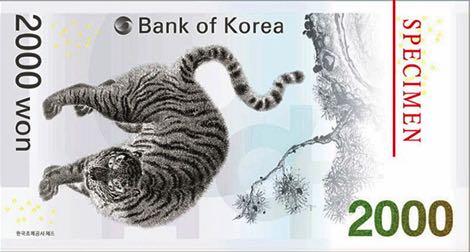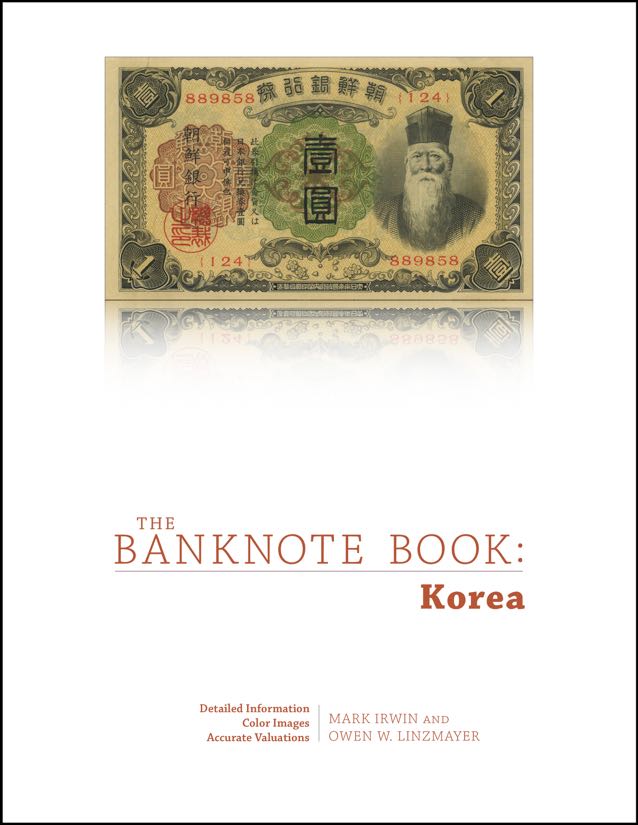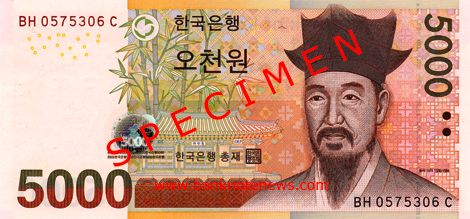South Korea
South Korea new 2,000-won Olympics commemorative note (BNP201) confirmed
11 12, 2017 11:55 Category: East and Southeast Asia | Commemorative
On 11 December 2017, the Bank of Korea introduced 2.8 million new 2,000-won notes to commemorate the Winter Olympic Games to be held 9 - 25 February 2018 in PyeongChang. Not intended for circulation, individual notes were packaged in a folder and sold for 8,000 won each. The bank also sold uncut pairs and sheets of 24 notes.


Courtesy of Sejin Ahn (http://www.facebook.com/myriakorea) and Jason Lee.


Courtesy of Sejin Ahn (http://www.facebook.com/myriakorea) and Jason Lee.
South Korea to introduce Winter Olympics commemorative note in 2017
22 12, 2016 11:42 Category: East and Southeast Asia | Commemorative
According to an article on KOREA.net dated 20 December 2016, in 2017 the Bank of Korea plans to introduce 2.8 million new 2,000-won notes to commemorate the Winter Olympic Games to be held 9-25 February 2018 in PyeongChang. The front features athletes from seven winter sports events (biathlon, ice hockey, curling, speed skating, ski jumping, luge, and bobsled), whereas the back features a tiger and a pine tree from by Joseon-era artist Kim Hong-do’s painting, Songhamaenghodo.


Courtesy of Jeonghyun Park and Craig Eustace.


Courtesy of Jeonghyun Park and Craig Eustace.
South Korea 2018 Winter Olympics commemorative note reported
30 05, 2016 07:15 Category: East and Southeast Asia | Commemorative
According to an article on Yonhap News Agency dated 29 May 2016, the Bank of Korea plans to issue the country's first legal tender commemorative banknote for the Winter Olympics set to take place in PyeongChang 9 - 25 February 2018. The Bank of Korea also plans to start selling sets of commemorative coins in November, composed of two gold, eight silver and one bronze.
Korea chapter of The Banknote Book is now available
12 05, 2016 22:44 Category: The Banknote Book | East and Southeast Asia

The Korea chapter of The Banknote Book is now available for individual sale and as a free download to subscribers.
This 19-page catalog covers notes issued by the Treasury Department in 1893, the First National Bank from 1902 to 1909, the Bank of Korea from 1910 to 1911, the Bank of Chosen from 1914 to 1947, and the Red Army Headquarters from 1945 to 1946. Published 13 May 2016.
Each chapter of The Banknote Book includes detailed descriptions and background information, full-color images, and accurate valuations. The Banknote Book also features:
- Sharp color images of note’s front and back without overlap
- Face value or date of demonetization if no longer legal tender
- Specific identification of all vignette elements
- Security features described in full
- Printer imprint reproduced exactly as on note
- Each date/signature variety assigned an individual letter
- Variety checkboxes for tracking your collection and want list
- Date reproduced exactly as on note
- Precise date of introduction noted when known
- Replacement note information
- Signature tables, often with names and terms of service
- Background information for historical and cultural context
- Details magnified to distinguish between note varieties
- Bibliographic sources listed for further research
Subscribe to The Banknote Book
If you collect the entire world or a large number of countries, buying a subscription is the best deal because it's less expensive than buying chapters individually, and it entitles you to every chapter currently available as well as everything published—or revised (click here to see the Change Log)—during the term of your subscription.

Sign up for Email Notifications
If you would like to receive email notifications whenever a new chapter of The Banknote Book is published, please join the email list.

South Korea's banknote printing firm secures Indonesia substrate contract
20 04, 2015 09:27 Category: East and Southeast Asia
According to an article in The Korean Times dated 20 April 2015, the Korea Minting and Security Printing Corporation (KOMSCO) is seeking customers outside of Korea to offset declines in production brought about by the introduction of a 50,000-won note (BOK B53) in 2009 and the public's increased usage of credit cards instead of cash. "KOMSCO signed a deal with the Indonesian government in February to supply 8 million 'security papers' with enhanced security functions for 880 million won over the next three years," said CEO Kim Hwa-dong. The article mentions that KOMSCO has produced banknotes for the Indonesian government in the past several years, but doesn't identify precisely which notes it printed. Curiously, all current notes in Indonesia (BI B104-B108) bear the imprint PERUM PERCETAKAN UANG RI IMP and make no mention of KOMSCO.
South Korea banknote printer seeking more overseas contracts
24 06, 2014 12:34 Category: Asia

According to an article in Korea Times dated 24 June 2014, Korea Minting, Security Printing & ID Card Operating Corp. (KOMSCO) has seen its production volume halved over the past five years, and hopes to utilize excess capacity by obtaining contracts to print banknotes for other countries. Countries for which KOMSCO has produced or is producing "currencies" (may include coins, not just banknotes) include China, Indonesia, Israel, Japan, Libya, Peru, Switzerland, Thailand, and Vietnam. Last year KOMSCO won an order from Peru to produce 305 million 50-nuevo sole notes, with delivery to be completed by the end of June 2014.
South Korea chapter of The Banknote Book is now available
16 08, 2012 18:29 Category: The Banknote Book | East and Southeast Asia

The South Korea chapter of The Banknote Book is now available for individual sale and as a free download to subscribers.
At the time of initial publication, this 18-page catalog covers every note (159 types and varieties, including 62 notes unlisted in the SCWPM) issued by the Bank of Chosen from 1945 to 1950, and the Bank of Korea from 1949 to present day.
Each chapter of The Banknote Book includes detailed descriptions and background information, full-color images, and accurate valuations. The Banknote Book also features:
- Sharp color images of note’s front and back without overlap
- Face value or date of demonetization if no longer legal tender
- Specific identification of all vignette elements
- Security features described in full
- Printer imprint reproduced exactly as on note
- Each date/signature variety assigned an individual letter
- Variety checkboxes for tracking your collection and want list
- Date reproduced exactly as on note
- Precise date of introduction noted when known
- Replacement note information
- Signature tables, often with names and terms of service
- Background information for historical and cultural context
- Details magnified to distinguish between note varieties
- Bibliographic sources listed for further research
Subscribe to The Banknote Book
If you collect the entire world or a large number of countries, buying a subscription is the best deal because it's less expensive than buying chapters individually, and it entitles you to every chapter currently available as well as everything published—or revised (click here to see the Change Log)—during the term of your subscription.

Sign up for Email Notifications
If you would like to receive email notifications whenever a new chapter of The Banknote Book is published, please join the email list by clicking the button below.

The Challenge: Identify gate on front of South Korea 100-won note of 1950
03 09, 2011 17:15 Category: East and Southeast Asia | Challenge
Today’s challenge is to identify the gate which appear on the front of the old 100-won notes of South Korea.
If you can precisely identify the name and location of this gate—or have a lead which you think might be useful—please post a comment, preferably including a URL which links to evidence supporting your identification.
The following image appears on the front of the 100-won note of South Korea from 1950 (Pick 7):

IDENTIFIED: Gwanghwamun gate to Gyeongbokgung palace in Seoul.
Courtesy of José Fabrício Macêdo.
If you can precisely identify the name and location of this gate—or have a lead which you think might be useful—please post a comment, preferably including a URL which links to evidence supporting your identification.
The following image appears on the front of the 100-won note of South Korea from 1950 (Pick 7):

IDENTIFIED: Gwanghwamun gate to Gyeongbokgung palace in Seoul.
Courtesy of José Fabrício Macêdo.
South Korea 1983 1,000-won varieties reported
09 12, 2009 09:13 Category: East and Southeast Asia
Color varieties for South Korea 1,000-won (US$0.85) note (Pick 47) from 1983 have recently been reported. Specifically, it appears that the portrait on the front and the buildings on the back are purple on one variety, and brown on the other variety. Furthermore, on the “purple” variety, the numerals 1000 at lower right on back are blue, whereas they are purple on the “brown” variety. Finally, the engraving or printing on the “brown” variety appears sharper than the “purple” variety, though there are no other differences in the text, underprinting, watermarks, or other security features.
The scans below were created at the same time, so the color variations are not a result of differences in the equipment. Collectors are encouraged to examine their notes and report if they can verify these differences on other examples. Also, I would appreciate hearing from collectors who can determine which of these notes came first based upon their serial number prefixes.
 Purple
Purple Brown
Brown
 Purple
Purple
 Brown
Brown
Courtesy of Kevin Klauss.
The scans below were created at the same time, so the color variations are not a result of differences in the equipment. Collectors are encouraged to examine their notes and report if they can verify these differences on other examples. Also, I would appreciate hearing from collectors who can determine which of these notes came first based upon their serial number prefixes.
 Purple
Purple Brown
Brown Purple
Purple Brown
BrownCourtesy of Kevin Klauss.
South Koreans frustrated by 50,000-won notes
20 11, 2009 12:22 Category: East and Southeast Asia


According to a Korea Times article dated 11-10-2009, some South Koreans have difficulty distinguishing between the new 50,000-won (US$43.20) note and the old 5,000-won (US$4.30) note due to “their physical similarity” and are calling for the government to change the color of the highest-value banknotes.
The Bank of Korea, however, says no countermeasures are being considered at this time, adding there are several identification devices applied to the bills: The 50,000-won bills are longer than 5,000-won notes by 12 millimeters, and a hologram on their surface is easily noticeable in dark places. "Such criticism is somewhat groundless because U.S. dollar bills are issued all in the same color but not subject to such confusion," a BOK official said on condition of anonymity. "The two bills are different in color, as 50,000-won bills are yellow and 5,000-won bills are reddish-yellow."
It’s hard to imagine how anyone can confuse the two notes since they are of clearly different colors, feature very different portraits, and have easily distinguishable security threads and holographic elements. However, I gave some thought to the BOK official’s defense that the US dollar isn’t subject to confusion. Perhaps it is precisely because the US notes are all the same size and approximate color that the public is forced to pay particular attention to their printed denominations.
In this case, the US benefits from a limited number of denominations, all of which can be expressed by one, two, or three easily distinguished digits: 1, 2, 5, 10, 20, 50, and 100. When looking at the 5,000- and 50,000-won notes, you see that it’s not easy to know the denomination at a glance because you must stop to count the zeros. An easy fix to this problem would be to use a space-holder character such as a comma, or make the last three zeros shorter than the other digits so that the 5 and 50 would stand out.
South Korea issues new 50,000-won note
23 06, 2009 11:19 Category: East and Southeast Asia
On 23 June 2009, the Bank of Korea issued its first-ever 50,000-won note, now the highest denomination in the country.


50,000 won (US$38.85)
Yellow and green. Front: Tree branches, grape leaf, berries, and eggplant; painter and author Shin Saim-dang. Back (vertical): Bamboo tree and Japanese apricot tree. Holographic stripe with demetalized BANK OF KOREA 50000. Windowed Motion security thread. Solid security thread with demetalized 한국은행 50000. Watermark: Shin Saim-dang and electrotype 5 within pentagon. Printer: 한국조폐공사 제조 (Korea Minting & Security Printing Corporation). 154 x 68 mm.
Courtesy of Sejin Ahn.


50,000 won (US$38.85)
Yellow and green. Front: Tree branches, grape leaf, berries, and eggplant; painter and author Shin Saim-dang. Back (vertical): Bamboo tree and Japanese apricot tree. Holographic stripe with demetalized BANK OF KOREA 50000. Windowed Motion security thread. Solid security thread with demetalized 한국은행 50000. Watermark: Shin Saim-dang and electrotype 5 within pentagon. Printer: 한국조폐공사 제조 (Korea Minting & Security Printing Corporation). 154 x 68 mm.
Courtesy of Sejin Ahn.
South Korea to issue new 1,000- and 10,000-won notes in 2007
23 10, 2006 10:41 Category: East and Southeast Asia



The Bank of Korea (BOK) announced that newly-designed 1,000- and 10,000-won notes with strengthened anti-forgery features will begin circulating on January 22, 2007. For more information, read this The Korea Times article and this one.
The Korea Minting and Security Printing Corporation has been delivering the new W1,000 notes to the BOK since May 19, 2006, and began printing the new W10,000 banknotes on July 7, 2006.
Update (12/22/06): Lawmakers were poised to approve the introduction of larger denominations as early as 2008.
South Korea issues new 1,000- and 10,000-won notes
22 01, 2007 18:05 Category: East and Southeast Asia




The Bank of Korea (BOK) issued newly-designed 1,000- and 10,000-won notes with strengthened anti-forgery features (including watermarks shown above) on January 22, 2007. For more information, visit the BOK’s web site dedicated to the new family of notes.
Courtesy of banknoteshop@gmx.net.

